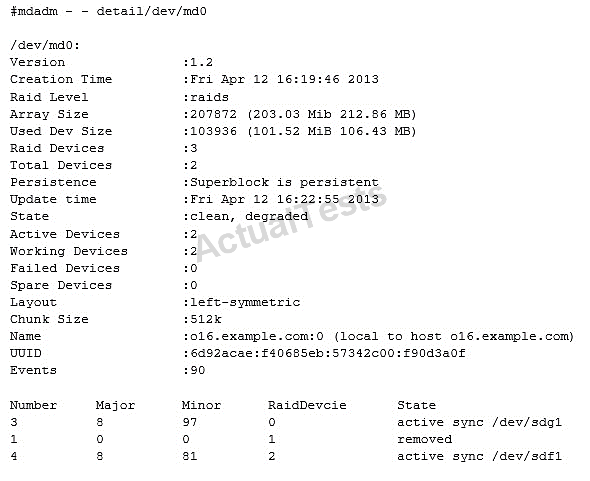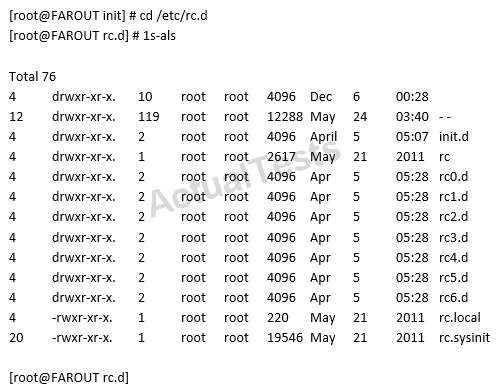Download Oracle Linux 5 and 6 System Administration.1z0-100.ActualTests.2021-12-05.66q.vcex
| Vendor: | Oracle |
| Exam Code: | 1z0-100 |
| Exam Name: | Oracle Linux 5 and 6 System Administration |
| Date: | Dec 05, 2021 |
| File Size: | 564 KB |
How to open VCEX files?
Files with VCEX extension can be opened by ProfExam Simulator.
Discount: 20%
Demo Questions
Question 1
Which statements is true concerning Oracle Linux configuration files for users and groups?
- The /etc/passwd file contains hashed passwords for each user.
- The /etc/shadow file contains hashed passwords for each user.
- The GECOS field in /etc/passwd file may be empty.
- The /etc/group file contains the group name and the hashed group password.
Correct answer: B
Explanation:
/etc/shadow file stores actual password in encrypted (one-way hashed) format for user's account with additional properties related to user password i.e. it stores secure user account information /etc/shadow file stores actual password in encrypted (one-way hashed) format for user's account with additional properties related to user password i.e. it stores secure user account information
Question 2
This MDADM output:

Which two aspects can be determined from this output?
- A device failed and has been removed from this RAID set.
- It is no longer possible to write to this RAID set.
- Read and write performance is no longer optimal on this RAID set.
- This RAID set was built without a spare device.
- Only Write performance is no longer optimal on this RAID set.
Correct answer: AD
Question 3
Which two software packages are prerequisites for enabling the configuration and use of a Network information Service (Nis) client?
- nis-tools
- slapi-nis
- ypbind
- nisserv
- nisbind
- yp-tools
Correct answer: CF
Explanation:
ypbind finds the server for NIS domains and maintains the NIS binding information. The client (normaly the NIS routines in the standard C library) could get the information over RPC from ypbind or read the binding files. ypbind finds the server for NIS domains and maintains the NIS binding information.
The client (normaly the NIS routines in the standard C library) could get the information over RPC from ypbind or read the binding files.
Question 4
Which statement is true concerning the /etc/sysconfig directory and its files and subdirectories?
- The contents are always the same for a specific version of the Oracle Linux Kernel.
- The file /etc/sysconfig/init is used by upstart to control the attributes of the tty devices that get started.
- The directory /etc/sysconfig/network-scripts contains files that must not be modified while the network is up.
- The files only contain default values for certain daemon processes.
Correct answer: B
Explanation:
The /etc/sysconfig/init file controls how the system appears and functions during the boot process. Note: The /etc/sysconfig directory contains files that control your system's configuration. The contents of this directory depend on the packages that you have installed on your system The /etc/sysconfig/init file controls how the system appears and functions during the boot process.
Note: The /etc/sysconfig directory contains files that control your system's configuration. The contents of this directory depend on the packages that you have installed on your system
Question 5
Examine the routing table:

Which three statements are true concerning the routing of IP packets?
- Traffic to 192.168.180.180 is routed via eth1.
- Traffic to 192.168.180.240 is routed via eth1.
- Traffic to 192.168.0.42 is routed via eth2.
- Traffic to 192.168.42.42 is routed via eth2.
- Traffic to 192.168.42.42 is routed via eth0.
- Traffic to 192.168.180.180 is routed via eth0.
Correct answer: ACD
Question 6
You have a single network adapter called eth0.
DEVICE = eth0
BOOTPROTO=DHCP
HWADR=BC:305B:C5:63;F1
NM_CONTROLLED=no
ONBOOT=YES
TYPE=Ethernet
PEERDNS=no
UUID=C9dba2e8-9faf-4b77-bbe2-92dd81dda1f9
Which two statements are true concerning eth0 based on this configuration?
- DHCP is used to obtain a lease on an IP address.
- The dhclient command may only be used to obtain a lease at boot time.
- dhclient does not override the contents of /etc/resolv.conf.
- DNS is not used to resolve host names for this adapter.
- dhclient overrides the contents of /etc/resolv.conf.
Correct answer: AC
Explanation:
A: BOOTPROTO=DHCPC: PEERDNS=answerwhere answer is one of the following:yes — Modify /etc/resolv.conf if the DNS directive is set. If using DHCP, then yes is the default. no — Do not modify /etc/resolv.conf. Note: The "/etc/resolv.conf" file is used to configure the location of the DNS servers to be used for name resolution. A: BOOTPROTO=DHCP
C: PEERDNS=answer
where answer is one of the following:
yes — Modify /etc/resolv.conf if the DNS directive is set. If using DHCP, then yes is the default.
no — Do not modify /etc/resolv.conf.
Note: The "/etc/resolv.conf" file is used to configure the location of the DNS servers to be used for name resolution.
Question 7
You want sendmail to deliver mail for these users:
- [email protected] mailbox jsmith1
- [email protected] mailbox jsmith2
- [email protected] mailbox jsmith3
In which sendmail configuration database can this requirement be defined?
- /etc/aliases
- /etc/mail/userdb
- /etc/mail/virtusertable
- /etc/mail/domaintable
- /etc/mail/genericstable
Correct answer: C
Explanation:
/etc/mail/virtusertable This database file maps mail addresses for virtual domains and users to real mailboxes. These mailboxes can be local, remote, aliases defined in /etc/mail/aliases, or files. This allows multiple virtual domains to be hosted on one machine. The following example demonstrates how to create custom entries using that format:[email protected] root [email protected] [email protected] @example.com joe /etc/mail/virtusertable
This database file maps mail addresses for virtual domains and users to real mailboxes. These mailboxes can be local, remote, aliases defined in /etc/mail/aliases, or files.
This allows multiple virtual domains to be hosted on one machine.
The following example demonstrates how to create custom entries using that format:
- [email protected] root
- @example.com joe
Question 8
Refer to the Exhibit.
[root@server1 ~ # 1s -1 /usr/bin/passwd
-r-x—x—x 1 root root 21200 oct 7 21:01 /usr/bin/passwd
[root@server1 ~] # 1s -1 /etc/shadow
-r - - - - - - - - 1 root root 1818 Mar 7 10:31 /etc/shadow]
[root@server1 ~]#
A user smith is on your system complained that he is not able to change his password. As the administrator, you long-listed the passwd command and the /etc/shadow file.
View the Exhibit that shows the output.
What must you do to enable this user to change his password?
- Set SGID on /usr/bin/passwd.
- Set SUID on /usr/bin/passwd.
- Set sticky bit on /usr/bin/passwd.
- Set read and write permission for others on /etc/shadow.
- Set permission on /etc/shadow to 600.
Correct answer: B
Question 9
What happens if you reboot a Ksplice Uptrack-enabled system when the following conditions exist?
- The Internet is unreachable due to a failing router.
- The INSTALL_ON_REBOOT property is set to YES in /etc/uptrack/uptrack.conf.
- The Ksplice updates are applied early in the boot sequence despite the fact that the Internet is unreachable.
- The Ksplice updates are not applied during the boot sequence, but they will be applied as soon as the Internet becomes reachable again.
- The updates are not applied during the boot sequence and will not be applied after the Internet has become reachable again.
- The system waits in the boot sequence for the internet to become reachable again.
- The system boots to single-user mode.
Correct answer: A
Explanation:
* # Automatically install updates at boot time. If this is set, on # reboot into the same kernel, Uptrack will re-install the same set of # updates that were present before the reboot. install_on_reboot = yes * To install updates automatically at boot time, the following entry must appear in /etc/uptrack/uptrack.conf:install_on_reboot = yes * # Automatically install updates at boot time. If this is set, on
# reboot into the same kernel, Uptrack will re-install the same set of
# updates that were present before the reboot.
install_on_reboot = yes
* To install updates automatically at boot time, the following entry must appear in
/etc/uptrack/uptrack.conf:
install_on_reboot = yes
Question 10
Examine the content of /etc/rc.d:

Which four statements are about the use of these files and directories by UPSTART?
- /etc/rc.d/rc is executed each time the /sbin/init command us used, to change services appropriately for the target run level.
- /etc/rc.d/rc.local is executed at boot time, before the run level processing takes place.
- /etc/rc.d/rc is executed at boot time, to start the appropriate services for the run level defined in /etc/initab.
- /etc/rc.d/rc.sysinit is executed once at boot time, regardless of which run level is set.
- /etc/rc.d/rc.sysint is executed each time the /sbin/init command is used to change the run level.
- /etc/rc.d/rc3.d contains links to scripts in /etc/init.d.
- /etc/rc.d/rc is executed after /etc/rc.d/rc.local.
Correct answer: ACDF
HOW TO OPEN VCE FILES
Use VCE Exam Simulator to open VCE files

HOW TO OPEN VCEX AND EXAM FILES
Use ProfExam Simulator to open VCEX and EXAM files


ProfExam at a 20% markdown
You have the opportunity to purchase ProfExam at a 20% reduced price
Get Now!



